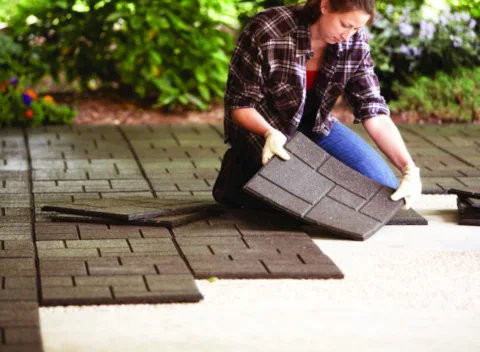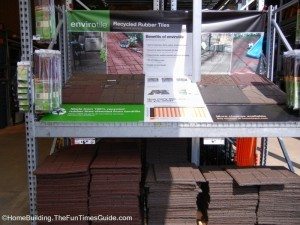I saw a great looking home product that was made with recycled rubber tires recently.

They were rubber tiles — or rubber pavers — that you can use on your deck or patio.
The brand name is envirotile made by Multy Home.
What Envirotiles Are Like
Envirotiles are made from 100% tire crumbs from rubber tires that have been diverted from landfills. That’s a big plus in my book, because we toss millions of tires in the landfill each year.
If you are a homeowner and you’re thinking about making your deck or patio look fresh, this is the type of product that you feel a little better handing over your hard-earned cash for — because tires are a huge source of landfill headaches, and anything we can do as consumers to increase the landfill diversion of tires is a BIG plus.
Check out the life cycle of a tire.
I wouldn’t want to buy a product just for the sole reason of it being green. It also has to have value for me, the consumer.
There are several cool things about envirotiles.
Renew the look of your space in minutes; tiles can be used on any flat surface including balconies, patios, decks, sun-rooms, pools, playgrounds and sheds. They can also be installed on the ground using the same method as traditional pavers. — Multy Home
Pros of Envirotiles Rubber Tiles
- There are grooves on the underside of the tiles that allow for airflow and water to pass through. I can tell you from experience that having grooves on the underside is a much needed feature.
 I have a rubber mat at a side entrance to my house that has had underlying moisture problems if I fail to temporarily move it from time to time. Maybe I should just get rid of it and get a couple of envirotiles instead.
I have a rubber mat at a side entrance to my house that has had underlying moisture problems if I fail to temporarily move it from time to time. Maybe I should just get rid of it and get a couple of envirotiles instead. - Envirotiles are made in Canada and right here in the U.S. (Dalton, GA). You’ve got to support domestic industries, whenever possible. This sort of qualifies under that category because some of it is Georgian-made.
- This is part of a complete system that you put together with clips on the outermost 2 rubber tiles to lock in the floating portion in the center. Yep, it’s a floating floor system.
- They are versatile. You can install them on top of any existing floor. Got a wooden deck that is structurally sound but doesn’t look so good? Install these on top of them for a fresh, new look.
Cons of Envirotiles Rubber Tiles
There are 2 definite downsides, and 1 possible one:
- The nature of rubber is to heat up when the sun is blasting it. You’ll need to be cautious in the summertime by wearing shoes when walking on envirotiles.
- Relatively high cost. This is a recycled product. So, like many other green products, envirotiles are a little more expensive in comparison to concrete pavers (which can’t be used in the same manner as rubber tiles). The price at Home Depot at time of publishing was $6.99 per 18×18 tile. A decorative 16×16 concrete paver was around $4. Keep in mind that pavers are much different from rubber tiles, but I wanted to give a comparison. You could cover a 10’x10′ area for around $400 using envirotiles.
- There is a third possible problem that I read about in a comment from a consumer. He claimed that several of the rubber tiles were not square, which caused issues during the course of his project. I’m not sure how that could happen because these things are obviously stamped out over and over again from a template.
This is a product that is trying to do good all around. It’s recycled material. It’s recyclable. It’s a viable consumer product for homeowners.
This rubber tile overlay on an old deck– using envirotiles — is definitely a DIY project.



